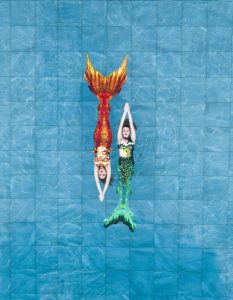
'Minimal synchro is to synchronised swimming what contemporary dance is to ballet. It is a smooth, elegant version of synchronised swimming." It’s graceful, fluid movements created by the swimmers make it ideal for an ambient synchronised swimming act.
Konstantina
Galiotou, our founder, has always had a different perception of what
synchronised swimming is. Ever since her young years, while she was a
professional athlete in the Greek National Synchronised swimming team, she envisioned
synchronised swimming more as a ballet show and less as a sport, focusing
mostly on the aesthetics and the viewers perspective.
Through our
work, we came across Kostas Spathis ( a.k.a. @spathumpa), a famous
intstagrammer and Greek drone photographer. His strong minimalistic aesthetic
matched Konstantina’s style perfectly. Surprisingly enough, they share a common
background, as they are booth architects and ‘minimal’ is definitely something
that architects love.
Swimmers’
bodies creating organic floating, kaleidoscopic or symmetrical shapes are
elements that have traditionally been used in synchronised swimming over the
years, but make up only a small part of some routines. Our innovation in
minimal synchro is creating a whole choreography based on those elements.
Everything hinges on the different shapes created and how we move to form one
from the other.
The difference
between synchronised swimming and “our” minimal synchro is the plane we move on
and that which the view is set on. In synchronised swimming the action plane is
vertical, i.e. we care about how far above the surface a swimmer can dance and
we mainly watch the swimmer dancing perpendicular to the water surface. In
minimal synchro, the action plane is horizontal and it’s all about floating on
the surface, creating strong lines and clear symmetrical or kaleidoscopic
shapes.






